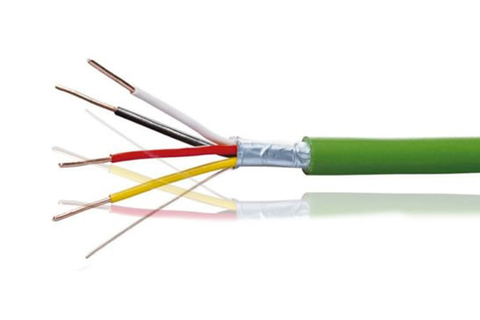You have probably heard of KNX, but do you know what it actually is? We asked Simon Johnson of Theben, an elected board member of KNX UK, to explain.

Electricians know that smart building technology ought to be on their radar if they aren’t going to get left behind, but there seems to be a myth that it’s only for high-end properties and for specialist installers. This is simply not the case!
Certainly, it does take a bit of effort to get your head around it, and you will need to invest significant time and, yes, cash, in boosting your knowledge and skills. But investing in yourself for the future is going to be worthwhile.
If you don’t start to think like a smart installer, then you will never be able to reap the satisfaction and profit margins that come with installing smart technology.
You’ve probably heard about KNX, the industry standard open protocol for smart building control. Its logo now appears on over 400 manufacturer’s products and is appearing more and more at trade shows and exhibitions. What is it all about and why is it the smart choice for installers?
What is KNX in a nutshell
KNX is a software protocol that is used globally – there are over 160,000 firms installing KNX systems around the world. Using the KNX hard-wired IP backbone, installers can combine products from hundreds of different manufacturers with guaranteed compatibility. Backed by manufacturers spending £millions (like Siemens, Schneider, ABB, Theben, JUNG, Zennio …. 419 manufacturers in total) on R&D, KNX clearly has a future.
While the international HQ of the Association is in Belgium, many countries have their own National Association – yours is KNX Australia. Its members are manufacturers, systems designers and integrators, consultants, training providers, wholesalers and new-to-KNX professional installers.
While its main objective is to spread the word about the benefits of KNX and the freedom installers get when not being tied to a single manufacturer’s product, your national association also acts as a network for sharing ideas and problem-solving.
No project too small
There is a misconception that KNX is only for the super-rich, living in 10 bedroomed homes with mind-blowingly expensive touch panels in every room. It’s time to dispel that myth. With over 400 manufacturers of KNX enabled devices and a growing number of KNX wholesalers, the product range, accessibility and pricing is on par with many proprietary smart home systems.
Of course, KNX is perfect for massive mansions as well as normal family homes. In fact, it is almost infinitely scalable and is suitable for all projects from kitchen extensions through to airports, skyscrapers, colleges and hospitals alike, including specialist applications such as assisted living or “later living”.
Simple wiring – ideal for an electrician
From an installer’s point of the view the cabling is simple. In the majority of cases it’s quicker to install than a traditional wiring system and, with point-to-point wiring, final testing is easy. KNX systems use an inexpensive RF-shielded cable. The distinctive green KNX 4 x 0.8mm bus cable runs to every KNX device in the building: actuators, switches, room controllers, push buttons, PIRs, multi-function displays and room thermostats.
You can daisy-chain, star or spur up to 64 devices on one line of bus cable alone, easily enough for a standard four bedroomed home. The bus cable can run alongside the mains cabling with no extra containment, no extra holes in the joists and no separate clipping runs.
Imagine a scenario of a kitchen-living-dining area with three entry doors, up to 10 lighting circuits (all of which are LED), with switching and dimming. The client would like each circuit to be three-way controlled or, even worse, they can’t make up their mind which switch should turn on which lighting circuit. It’s a situation we’ve all been in!
With conventional wiring, that would require some serious cable runs and modular switch plates and cabling connections, but with KNX it would be one single green cable daisy-chained to each switch and taken back to the distribution board. With KNX the customer can even change their mind as to switch functionality after the cabling has been completed.
Simple set up
You need a laptop, a version of the KNX ETS software, a USB interface and some training. It’s like anything new, at first it seems odd to be programming the switching and dimming of light fittings with a laptop, but it soon becomes second nature and the flexibility it gives you and your clients is worth the investment. As qualified electricians, you work with calculations, specifications and technical drawings every day – It is completely within your grasp.
Find out more at http://www.knx.org.au/.
Is it expensive?
Good software isn’t free, take a look at any professional software package. The KNX Organisation offers three different versions of the latest ETS5 software to suit the size of projects you’re most likely to be involved in:
Demo – this version is FREE and will allow you to use up to five KNX devices, possibly enough for an open plan kitchen-living-dining extension or conversion.
Lite – allows up to 20 devices to be programmed.
Professional – is totally open with no restrictions on the number of devices in your project.
Winning a commercial contract or residential job is usually down to the cheapest quote – unless you can offer something your competitors can’t. You need to start thinking like a smart installer
The first step
Find out the basics of KNX at www.knx.org.au. Then get yourself along to one of the Association’s networking meetings to get a flavour of the support that members give each other. If you decide to join, membership is inexpensive and gives you the opportunity to network with people who can help you develop your knowledge and skills. They have lots of experience with KNX that they are willing to share because they all have an interest in KNX earning its rightful place as the preferred smart homes platform for creative installers.